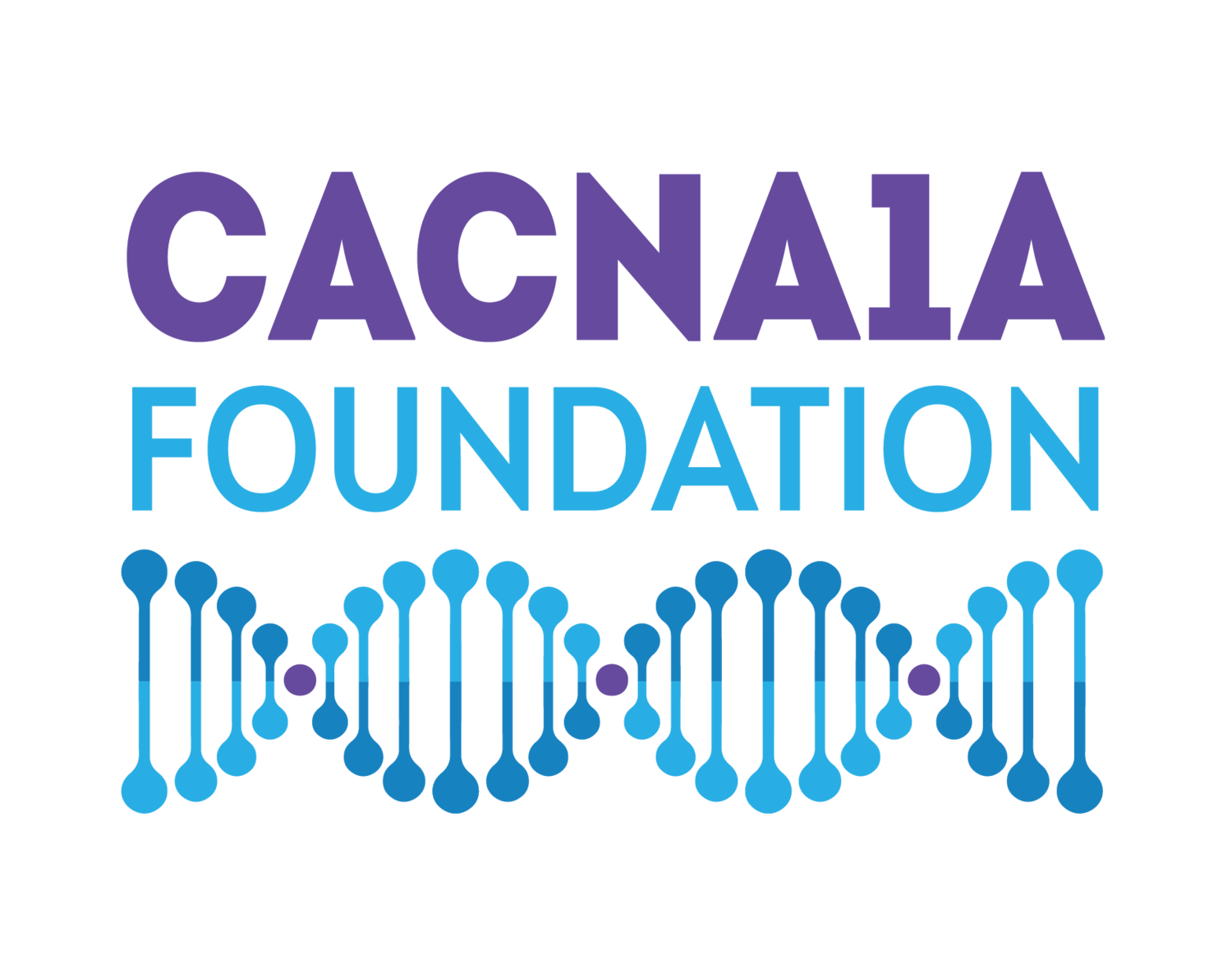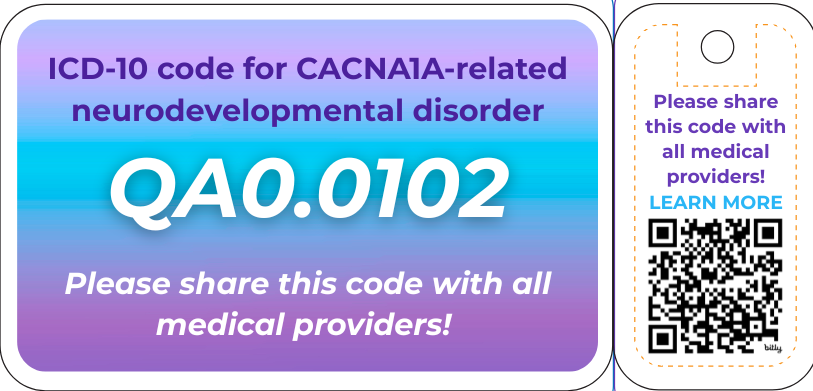Making CACNA1A-related Disorders Visible in the Healthcare System: Our New ICD-10 Code
CACNA1A-related Neurodevelopmental Disorder now has its own ICD-10 code! The code, QA0.0102, is a game-changer because it helps with:
● Providing better care and management
● Advancing research with more accurate data
● Attracting more interest from pharmaceutical companies to develop CACNA1A treatments
Families can help by sharing the code with their doctors and healthcare providers. Please request that it be used at the time of care.
To learn all about the ICD-10 code and order a card/keychain combo so you don’t forget the number, please read our full blog post below:
If you’d like us to send you a card/keychain combo, please fill out the form below:
What is an ICD-10 Code? ICD-10-CM stands for International Classification of Diseases, 10th Edition, Clinical Modification. It’s a system of codes made up of letters and numbers. Doctors, hospitals, and insurance companies use these codes to label and organize health conditions.
The World Health Organization creates the codes, and in the U.S., they are managed by the CDC. Every time you get medical care, doctors record your symptoms and diagnoses using ICD-10 codes. There are codes for almost everything—from epilepsy, food allergies, and using a wheelchair, to even unusual things like getting bitten by a duck.
These codes become part of your medical record and also go into large healthcare databases. The databases help researchers and healthcare systems identify patterns and improve care, but they do not include private information such as your name or contact details.
Why does a unique code matter? Doctors and hospitals can now clearly link specific symptoms to CACNA1A-related Neurodevelopmental Disorder. Until now, this disease has been hidden within broad medical codes like epilepsy, ataxia, or developmental delay. This made it very hard for doctors and researchers to track the condition, study it properly, or understand how it affects people over time. The new ICD-10 code changes that. It will assign CACNA1A-related neurodevelopmental disorder (CACNA1A-NDD) its own specific code, making it easier to visualize the complete picture of how symptoms progress, how treatments work, and what care is required. This information will not only benefit researchers and doctors but also enhance care management, inform the development of new treatments, and support families in accessing insurance coverage.
“With an ICD-10 code, CACNA1A can now be documented and studied more consistently across hospitals and databases worldwide. This is invaluable because it helps researchers better understand the condition, supports patient recruitment for clinical trials, and encourages pharma companies to invest in therapies.”- Brandon Farley, PhD, family member of an individual with CACNA1A and a scientist with 15 years of drug development experience.
How will the code appear in medical records? Here's a sample of what a medical record for a CACNA1A patient might look like post-rollout:
How the code can be used: A pediatric neurologist might be treating a young child who presents with developmental delay, hypotonia, ataxia, and speech delay. Initially, unsure of a unifying diagnosis, they discover a CACNA1A variant through genetic testing. By looking up QA0.0102, the ICD-10 code for CACNA1A-related neurodevelopmental disorder, the doctor can quickly find resources and treatment guidance. They learn that developmental and speech delays often benefit from early intervention services such as speech and occupational therapy, while ataxia can improve with physical therapy tailored to the child's motor profile. Some patients respond well to medications that stabilize motor coordination and potentially reduce seizure risk. The doctor may also note that chronic constipation is common in patients with CACNA1A and refer the child to a gastrointestinal specialist. Through this diagnostic clarity, physicians are better equipped to provide comprehensive, targeted care.
Another use for our ICD-10 code could be that a pharmaceutical company has a new anti-epileptic drug and could retrieve information about how many CACNA1A patients would be eligible to enroll in their clinical trials.
“From an industry perspective, having an ICD-10 code is a huge step that can help empower companies to move forward with research on CACNA1A experimental therapies. This classification not only supports better patient care, it also allows researchers to understand the size of a potential population and what their current treatment regimen includes, providing a rich trove of insight to de-risk future research and drug development.” - Hala Mirza, CACNA1A Board Member with 25 years of biopharma industry experience.
How you can help: You can be part of this transformative moment by sharing the code with your physicians and encouraging them to utilize it starting October 1st, 2025. Talk to other families and clinicians about what this code means, and why it matters. Every action helps us build momentum and ensures that CACNA1A-related Neurodevelopmental Disorders are no longer invisible in the healthcare system.
“As a pediatrician and rare disease Mom, I have a unique perspective on both living in the rare disease world and the difficulties of practicing modern medicine. Many physicians are not educated on the importance of ICD-10 codes for research or population health purposes. It will take parents requesting the specific code, QA0.0102, be entered to make this happen—but in MOST cases, physicians are very happy to help in fast and easy ways!” - Deborah Ondrasik, MD, CACNA1A parent and Foundation Board Member.
Want to Learn More?
Code Breakdown: What do the letters and numbers mean?
The code may appear random, but it was generated using a hierarchical system for naming codes. Here is the breakdown of our ICD-10 code:
QA0 = Neurodevelopmental disorders related to specific genetic pathogenic variants
QA0.01 = Neurodevelopmental disorders related to pathogenic variants in specific genes
QA0.0100 = Neurodevelopmental disorders related to pathogenic variants in ion channel genes
QA0.0102 = CACNA1A-related neurodevelopmental disorder
This new code is the result of serious teamwork, passion, and persistence from advocates, families, clinicians, and organizations who have been working toward better awareness and care for our community. It is also thanks to our donors that we can undertake critical projects, such as this one. In late spring 2024, the CACNA1A Foundation partnered with COMBINEDBrain and several CACNA1A clinicians to develop an application for our own ICD-10 code. The application was submitted to the ICD-10 Coordination and Maintenance committee, which manages ICD-10 codes at the CDC.
Whether you’re living with CACNA1A-NDD, caring for someone who is, or cheering on the community from a distance, this milestone is something we can all be proud of. It’s a bold step forward, and we’re taking it together.




